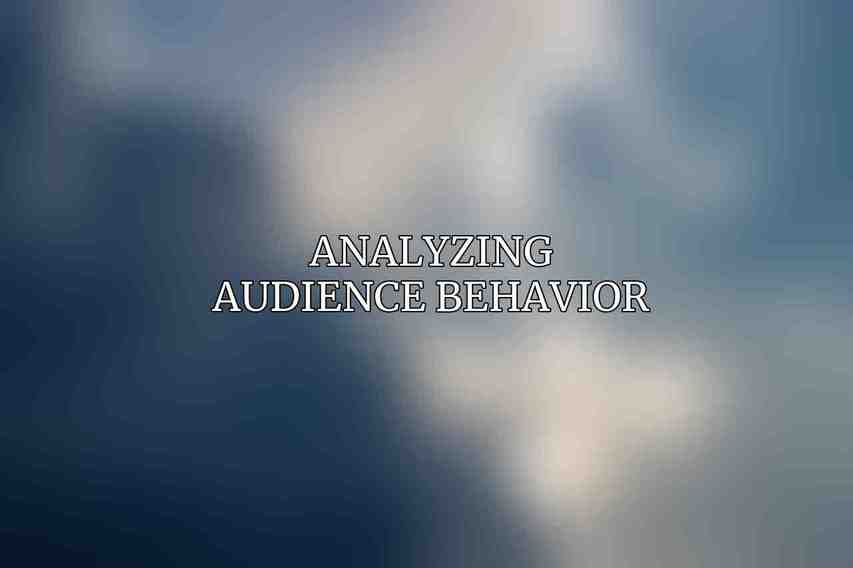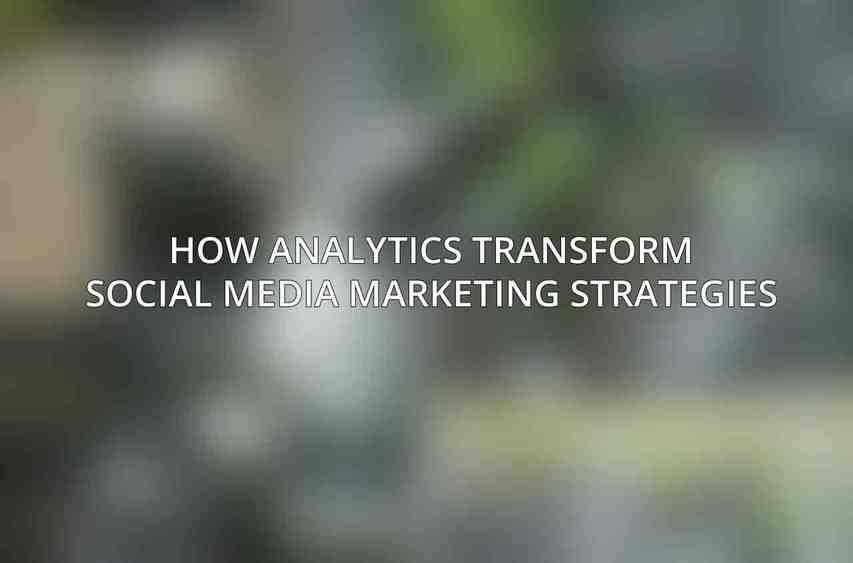the role of analytics has become increasingly crucial. Analytics involves the analysis of data to gain insights and make informed decisions. In social media marketing, analytics is the cornerstone of data-driven strategies. By leveraging analytics, businesses can understand their audience better, refine their marketing tactics, and ultimately drive success in their digital marketing efforts.
Definition and Importance of Analytics in Social Media Marketing
Analytics in social media marketing refer to the process of collecting, analyzing, and interpreting data from social media platforms to optimize marketing strategies. It allows marketers to measure the performance of their campaigns, understand audience behavior, and make data-driven decisions. Analytics provide quantifiable metrics that help in evaluating the effectiveness of marketing efforts and allocating resources wisely.
Benefits of Using Analytics in Social Media Marketing
The benefits of integrating analytics into social media marketing strategies are extensive. Some key advantages include:
- Improved targeting and segmentation
- Enhanced engagement with the audience
- Optimized content strategies
- Better ROI measurement
- Increased brand awareness and loyalty
Metrics that Matter
When it comes to social media analytics, there are several key metrics that marketers should focus on to gauge the performance of their campaigns effectively. These metrics can be categorized into various segments:
Engagement Metrics
Engagement metrics gauge how audiences interact with social media content. Examples include:
- Likes
- Comments
- Shares
- Retweets
- Replies
Reach Metrics
Reach metrics indicate the audience size and how many people see the content. Examples include:
- Impressions
- Follower count
- Reach
Conversion Metrics
Conversion metrics measure the effectiveness of turning social media interactions into desired actions. Examples include:
- Clicks
- Leads
- Sales
- Conversion rate
Customer Relationship Management (CRM) Metrics
CRM metrics focus on evaluating the quality of relationships with customers. Examples include:
- Customer lifetime value (CLV)
- Churn rate
Analyzing Audience Behavior

Understanding audience behavior is essential for crafting tailored and effective social media strategies. Analyzing audience behavior involves delving into various aspects:
Demographics
Demographics provide crucial information about the characteristics of the audience, such as:
- Age
- Gender
- Location
- Income level
Interests and Preferences
Exploring audience interests and preferences helps in creating content that resonates with them. Marketers can gather insights on:
- Hobbies
- Activities
- Preferences
Content Consumption Patterns
Analyzing how audiences consume content can help in creating a more engaging content strategy. This includes tracking:
- Preferred content types
- Popular content topics
- Peak engagement times
Engagement Patterns
Studying how audiences engage with content can reveal opportunities for improving interactions. Marketers can monitor:
- Types of engagement (likes, comments, shares)
- Engagement trends over time
Sentiment Analysis
Sentiment analysis involves determining the emotional tone of social media conversations around a brand. It helps in understanding:
- Positive sentiment
- Negative sentiment
- Neutral sentiment
Using Insights to Drive Engagement and Conversion

Analytics insights play a pivotal role in enhancing engagement and boosting conversions on social media platforms. Marketers can leverage these insights in various ways:
Content Optimization
By analyzing the performance of different types of content, marketers can identify what resonates best with their audience. This involves:
- Creating more of high-performing content
- A/B testing to refine content strategies
Audience Targeting
Segmenting the audience based on analytics insights allows marketers to deliver more personalized content. This includes:
- Refining target audience segments
- Tailoring content to specific audience interests
Campaign Measurement and Optimization
Continuous tracking and analysis enable marketers to optimize campaigns on-the-go. This involves:
- Monitoring campaign performance
- Making data-driven adjustments
- Testing different messaging and visuals
Social Media Monitoring
Being proactive in social media listening helps in staying attuned to customer feedback and sentiments. This includes:
- Responding to customer queries
- Addressing concerns in real-time
Influencer Marketing
Analyzing influential individuals in the industry can guide businesses in forming beneficial partnerships. This involves:
- Identifying key influencers
- Collaborating with influencers for brand promotion
- Measuring the impact of influencer campaigns
Analytics Tools and Platforms
Various tools and platforms exist to aid marketers in extracting and interpreting data for social media analytics purposes. These include:
Native Social Media Analytics
Third-Party Analytics Tools
Social Media Management Tools
Data Visualization Tools
Case Studies and Examples
Real-world examples demonstrate the power of analytics in reshaping social media marketing strategies. Case studies highlight successful implementations, best practices, and lessons learned.
Real-world examples of how analytics transformed social media marketing strategies
- Company X increased its conversion rate by 20% by optimizing content based on analytics insights.
- Brand Y improved engagement by 30% through targeted audience segmentation using analytics data.
Success stories and best practices
- Organization Z grew its customer base by 25% with influencer marketing strategies guided by analytics.
- Business W achieved a 15% increase in ROI by continuously monitoring and optimizing social media campaigns.
Common pitfalls and lessons learned
- Company A learned the importance of data accuracy in analytics after a failed campaign due to inaccurate insights.
- Brand B recognized the significance of real-time monitoring following a crisis that could have been averted with timely insights.
Best Practices for Using Analytics in Social Media Marketing
To leverage analytics effectively in social media marketing, marketers should adhere to best practices that ensure optimal utilization of data-driven insights.
Setting Clear Goals and Objectives
Define clear objectives that align with your overall marketing strategy and business goals.
Establishing Key Performance Indicators (KPIs)
Identify and monitor key metrics that directly impact the success of your social media campaigns.
Regular Data Collection and Analysis
Consistently collect data and analyze insights to track performance and make informed decisions.
Data Interpretation and Actionable Insights
Translate data into actionable insights that drive strategic decisions and improvements in marketing tactics.
Communication and Collaboration with Stakeholders
Ensure effective communication and collaboration with team members and stakeholders to implement data-driven strategies seamlessly.
the transformational impact of analytics on social media marketing strategies cannot be overlooked. By intricately analyzing audience behavior, optimizing content, and leveraging insights for targeted engagement, businesses can achieve remarkable success in the digital world.
Summary of Key Points
- Analytics is essential for data-driven social media marketing strategies.
- Key metrics such as engagement, reach, conversion, and CRM play a vital role in gauging performance.
- Analytics tools and platforms facilitate the extraction and interpretation of data for strategic decision-making.
Future Trends in Social Media Analytics
The future of social media analytics is poised for advancements in AI-driven insights, real-time data monitoring, and enhanced personalization strategies.
Call to Action
Embrace the power of analytics in your social media marketing endeavors to unlock new opportunities, optimize strategies, and drive meaningful engagement with your audience.
By harnessing analytics effectively, businesses can navigate the ever-evolving social media world with precision and propel their marketing efforts towards unprecedented success.
Frequently Asked Questions
What is social media analytics?
Social media analytics is the process of gathering data from social media platforms to analyze and gain insights into performance, trends, and audience behavior.
How can analytics transform social media marketing strategies?
Analytics can provide valuable insights into audience demographics, interests, and engagement patterns, allowing marketers to optimize their strategies for better results.
What are some key metrics to track in social media analytics?
Some key metrics to track include engagement rate, reach, impressions, click-through rate, conversion rate, and follower growth.
How can businesses use social media analytics to improve ROI?
By analyzing data from social media platforms, businesses can identify what content resonates with their target audience and make data-driven decisions to improve ROI.
What are some popular tools for social media analytics?
Some popular tools for social media analytics include Hootsuite, Sprout Social, Buffer, Google Analytics, and Brandwatch.
